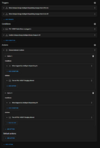Thanks for this - some good ideas here and integrations I hadn't noticed before.
BottleCapDave's Octopus integration provides much more info than the IO integration I was using previously. It seems though, that the octopus_energy_intelligent_dispatching sensor is only on during Octopus' IO charging slots - i.e. it might be off at times during the 23:30 - 05:30 "off peak" period.
I've gotten round that by defining an input_boolean helper for "IO Peak period" with automations to set it on or off due to time and dispatching status.
I'm also using the TeslaMate-provided MQTT entries to provide the Tesla charge limit for the 2nd automation. Those values are taken from the Tesla streaming API rather than polling, so there's no chance of waking the car. These are read-only though, so if you wanted to set the Tesla charge limit, you'd need to use the integration.
Cheers,
Tim
BottleCapDave's Octopus integration provides much more info than the IO integration I was using previously. It seems though, that the octopus_energy_intelligent_dispatching sensor is only on during Octopus' IO charging slots - i.e. it might be off at times during the 23:30 - 05:30 "off peak" period.
I've gotten round that by defining an input_boolean helper for "IO Peak period" with automations to set it on or off due to time and dispatching status.
I'm also using the TeslaMate-provided MQTT entries to provide the Tesla charge limit for the 2nd automation. Those values are taken from the Tesla streaming API rather than polling, so there's no chance of waking the car. These are read-only though, so if you wanted to set the Tesla charge limit, you'd need to use the integration.
Cheers,
Tim



